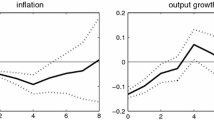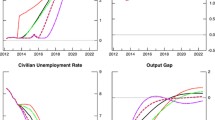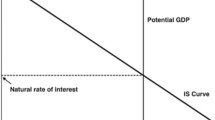Abstract
With the Federal Reserve widely expected to begin normalization of monetary policy in the wake of the Great Recession—perhaps in 2015—an important question for public policy and private-sector planning is what the “new normal” for interest rates is likely to be. In particular, are real interest rates likely to be lower in the future than in recent decades? An investigation through the use of the Kalman filter shows that the natural rate of interest—the real federal funds rate consistent with the economy operating at its full potential—has declined since 1980, especially after the Great Recession. This will have important implications for monetary policy and for the private sector, including recognition that the natural rate of interest is not fixed.



Similar content being viewed by others
References
Clark, Todd and Sharon Kozicki . 2005. “Estimating Equilibrium Interest Rates in Real Time.” The North American Journal of Economics and Finance, 16 (3): 395–413.
Congressional Budget Office, 2014. “The 2014 Long-Term Budget Outlook.” July 2014.
Hamilton, James D., Ethan S. Harris, Jan Hatzius and Kenneth D. West . 2015. The Equilibrium Real Funds Rate: Past, Present, and Future, presented at the U.S. Monetary Policy Forum, New York, February 27, 2015, http://research.chicagobooth.edu/igm/usmpf/2015.aspx.
International Monetary Fund, 2014. World Economic Outlook: April 2014. International Monetary Fund.
Laubach, Thomas and John C. Williams . 2003. “Measuring the Natural Rate of Interest.” Review of Economics and Statistics, 85 (4): 1063–1070.
Orphanides, Athanasios and John C. Williams . 2002. “Robust Monetary Policy Rules with Unknown Natural Rates.” Brookings Papers on Economic Activity, 33 (2): 63–146.
Orphanides, Athanasios and John C. Williams . 2007. “Robust Monetary Policy with Imperfect Knowledge.” Journal of Monetary Economics, 54 (5): 1406–1435.
Reifschneider, David and John C. Williams . 2000. “Three Lessons for Monetary Policy in a Low Inflation Era.” Journal of Money, Credit and Banking, 32 (4): 936–966.
Summers, Lawrence H. 2014. “U.S. Economic Prospects: Secular Stagnation, Hysteresis, and the Zero Lower Bound.” Business Economics, 49 (2): 65–73.
Williams, John C. 2003. “The Natural Rate of Interest,” Federal Reserve Bank of San Francisco Economic Letter, 2003-32, October 31.
Acknowledgements
Ben Pyle provided excellent research assistance in the preparation of this paper and the original presentation.
Additional information
This paper is based on the presentation for a NABE panel at the meeting of the Allied Social Sciences Associations: “The Outlook for the U.S. and Global Economy: Headwinds, Tailwinds and Whirlwinds” on January 3, 2015. The views expressed here are solely of the author and do not necessarily reflect those of others in the Federal Reserve System.
*John C. Williams took office as President and Chief Executive Officer of the Federal Reserve Bank of San Francisco on March 1, 2011. He was previously the Executive Vice President and Director of Research for the San Francisco bank, which he joined in 2002. He began his career in 1994 as an economist at the Board of Governors of the Federal Reserve System. Dr. Williams’ research focuses on topics including monetary policy under uncertainty, innovation, productivity, and business cycles. He currently serves as the managing editor of the International Journal of Central Banking and has previously served as associate editor of the American Economic Review. Additionally, he served as Senior Economist at the White House Council of Economic Advisers and as a lecturer at Stanford University’s Graduate School of Business. He earned an A.B. with high distinction from the University of California at Berkeley, a Master of Science with distinction in economics from the London School of Economics, and a Ph.D. in economics from Stanford University.
Rights and permissions
About this article
Cite this article
Williams, J. The Decline in the Natural Rate of Interest. Bus Econ 50, 57–60 (2015). https://doi.org/10.1057/be.2015.11
Published:
Issue Date:
DOI: https://doi.org/10.1057/be.2015.11




